Research on the International Roughness Index Threshold of Road Rehabilitation in Metropolitan Areas: A Case Study in Taipei City
Abstract
1. Introduction
2. International Roughness Index
2.1. The Analysis Mode of International Roughness Index
2.2. The Application of International Roughness Index
3. Implementation of the Road Smoothing Project
3.1. Contents of the Road Smoothing Project
3.2. Measuring Equipment
3.3. On-Site Inspection Method
4. Analysis and Discussion of Actual Measurement Results
4.1. Detection and Analysis of the IRI Value Before and After Road Leveling
4.2. Statistical Analysis of the IRI Value
4.3. Inspection on the Appropriateness of the IRI Threshold Value for Road Rehabilitation in Taipei City
4.4. Analysis of the Effectiveness of Road Leveling
5. Conclusions
- The IRI value before road leveling was mainly distributed between 5 and 8 m/km, while the IRI value after road leveling was mainly distributed between 3 and 5 m/km. The IRI value of the detected road section showed a downward trend, indicating that the implementation of the road leveling project had a significant effect on improving road smoothness.
- According to the histogram and cumulative curve of IRI values for the 171 asphalt concrete pavement sections, 84.80% of repaired roads had an IRI of < 4.5 m/km. Accordingly, it is recommended to set the IRI threshold for road rehabilitation in Taipei City to 4.50 m/km. This threshold is higher than Taiwan’s current ordinary road surface smoothness inspection standard. However, the speed of urban roads is relatively low, and comfortable driving can still be achieved under high IRI values. Therefore, considering the characteristics of traffic factors in metropolitan areas, this should be a reasonable standard.
- The cumulative distribution curve of IRI values can quickly estimate the number of kilometers of roads that must be maintained, and by using sorting and some basic information about the road conditions, we can quickly determine the section requiring maintenance and estimate the maintenance budget.
- Moderately lowering the IRI threshold for road maintenance in Taipei City can conform to the trend that other countries have set for gradually tightening the IRI threshold for roads.
Author Contributions
Funding
Acknowledgments
Conflicts of Interest
References
- Papagiannakis, A.T.; Masad, E.A. Pavement Design and Materials; John Wiley & Sons, Inc.: Hoboken, NJ, USA, 2012. [Google Scholar]
- Federal Highway Administration (FHWA). Pavement Smoothness Technologies. 2006. Available online: http://www.fhwa.dot.gov/teams/pavement/pave_5psm.cfm (accessed on 21 July 2020).
- Paterson, W.D.O. International Roughness Index: Relationship to Other Measures of Roughness and Riding Quality. Transportation Research Record 1084. In Proceedings of the 65th Annual Meeting of the Transportation Research Board, Washington, DC, USA, 13–16 January 1986. [Google Scholar]
- Sayers, M.W.; Gillespie, T.D.; Queiroz, C.A.V. The International Road Roughness Experiment: A Basis for Establishing a Standard Scale for Road Roughness Measurement; Transportation Research Record 1084; Transportation Research Board, National Research Council: Washington, DC, USA, 1986. [Google Scholar]
- Sayers, M.W.; Gillespie, T.D.; Queiroz, C.A.V. International Experiment to Establish Correlations and Standard Calibration Methods for Road Roughness Measurements; Technical Paper Number 45; World Bank: Washington, DC, USA, 1986. [Google Scholar]
- Sayers, M.W.; Gillespie, T.D.; Paterson, W.D. Guidelines for the Conduct and Calibration of Road Roughness Measurements; Technical Paper No. 46; World Bank: Washington, DC, USA, 1986. [Google Scholar]
- Al-Omari, B.; Darter, M.I. Relationship between International Roughness Index and Present Serviceability Rating; Transportation Research Record 1435; TRB: Washington, DC, USA, 1994. [Google Scholar]
- Sayers, M.W. On the Calculation of International Roughness Index from Longitudinal Road Profile. Available online: https://trid.trb.org/view/452992 (accessed on 30 September 2020).
- Sayers, M.W.; Karamihas, S.M. The Little Book of Profiling: Basic Information about Measuring and Interpreting Road Profiles; University of Michigan Transportation Research Institute: Ann Arbor, MI, USA, 1998. [Google Scholar]
- Hall, K.T.; Munoz, C.E.C. Estimation of Present Serviceability Index from International Roughness Index; Transportation Research Record 1655; Transportation Research Board: Washington, DC, USA, 1999. [Google Scholar]
- Swanlund, M. Enhancing Pavement Smoothness. Public Roads 2002, 64, 20–22. [Google Scholar]
- Du, Y.; Liu, C.; Wu, D.; Jiang, S. Measurement of International Roughness Index by Using Z-Axis Accelerometers and GPS. Math. Probl. Eng. 2014, 928980. [Google Scholar] [CrossRef]
- Arhin, S.A.; Williams, L.N.; Ribbiso, A.; Anderson, M.F. Predicting Pavement Condition Index Using International Roughness Index in a Dense Urban Area. J. Civil Eng. Res. 2015, 5, 10–17. [Google Scholar]
- ASTM International. Standard Practice for Computing International Roughness Index of Roads from Longitudinal Profile Measurements; ASTM E1926-08; ASTM International: West Conshohocken, PA, USA, 2015. [Google Scholar]
- Loprencipe, G.; Zoccali, P. Use of Generated Artificial Road Profiles in Road Roughness Evaluation. J. Mod. Transp. 2017, 25, 24–33. [Google Scholar] [CrossRef]
- Múčka, P. International roughness index specifications around the world. Road Mater. Pavement Des. 2017, 18, 929–965. [Google Scholar] [CrossRef]
- Loprencipe, G.; Pantuso, A.; Di Mascio, P. Sustainable pavement management system in urban areas considering the vehicle operating costs. Sustainability 2017, 9, 453. [Google Scholar] [CrossRef]
- Nguyen, L.H. Research on the Correlation Between International Roughness Index (IRI) and Present Serviceability Index (PSI), Recommendations on Evaluation Rates in Vietnam’s Conditions. Int. J. Eng. Res. Technol. 2017, 6, 266–271. [Google Scholar]
- Uechi, S.T.; Uechi, H. The Profiling of International Roughness Index (IRI) Based on Lagrangian Method. World J. Eng. Technol. 2018, 6, 885–902. [Google Scholar] [CrossRef][Green Version]
- Singh, D.K.; Gundaliya, P.J. Flexible Pavement Evaluation Using Profilometer for Unevenness. Int. Res. J. Eng. Technol. 2018, 5, 1024–1028. [Google Scholar]
- Zang, K.; Shen, J.; Huang, H.; Wan, M.; Shi, J. Assessing and Mapping of Road Surface Roughness based on GPS and Accelerometer Sensors on Bicycle-Mounted Smartphones. Sensors 2018, 18, 914. [Google Scholar] [CrossRef]
- Kırbaş, U. IRI Sensitivity to the Influence of Surface Distress on Flexible Pavements. Coatings 2018, 8, 271. [Google Scholar] [CrossRef]
- Mahmoudzadeh, A.; Golroo, A.; Jahanshahi, M.R.; Firoozi Yeganeh, S. Estimating Pavement Roughness by Fusing Color and Depth Data Obtained from an Inexpensive RGB-D Sensor. Sensors 2019, 19, 1655. [Google Scholar] [CrossRef] [PubMed]
- Loprencipe, G.; Zoccali, P.; Cantisani, G. Effects of Vehicular Speed on the Assessment of Pavement Road Roughness. Appl. Sci. 2019, 9, 1783. [Google Scholar] [CrossRef]
- Mirtabar, Z.; Golroo, A.; Mahmoudzadeh, A.; Barazandeh, F. Development of a crowdsourcing-based system for computing the international roughness index. Int. J. Pavement Eng. 2020. [Google Scholar] [CrossRef]
- Hossain, M.; Gopisetti, L.S.P.; Miah, M.S. Artificial neural network modelling to predict international roughness index of rigid pavements. Int. J. Pavement Res. Technol. 2020, 13, 229–239. [Google Scholar] [CrossRef]
- Liu, Y.; Du, T.; Xie, J. Development of the flatness detection system for cement concrete pavement construction phase. Mater. Sci. Eng. 2020, 892, 012040. [Google Scholar] [CrossRef]
- Song, Y.; Chen, R. Analysis method of vehicle Vibration response caused by pavement roughness. J. Traffic Transp. Eng. 2007, 7, 39–43. [Google Scholar]
- Wang, J.; Ma, J.; Ma, R. Study on calculation of dynamic displacement from time-frequency integration of acceleration. Comput. Sci. 2010, 37, 201–207. [Google Scholar]
- Thite, A.N.; Banvidi, S.; Ibicek, T.; Bennett, L. Suspension parameter estimation in the frequency domain using a matrix inversion approach. Veh. Syst. Dyn. 2011, 49, 1803–1822. [Google Scholar] [CrossRef]
- Loprencipe, G.; Zoccali, P. Ride Quality Due to Road Surface Irregularities: Comparison of Different Methods Applied on a Set of Real Road Profiles. Coatings 2017, 7, 59. [Google Scholar] [CrossRef]
- Cantisani, G.; Loprencipe, G. Road roughness and whole body vibration: Evaluation tools and comfort limits. J. Transp. Eng. 2010, 136, 818–826. [Google Scholar] [CrossRef]
- Yu, J.; Chou, E.; Yau, J.T. Development of speed-related ride quality thresholds using international roughness index. Transp. Res. Rec. J. Transp. Res. Board. 2006, 1, 47–53. [Google Scholar] [CrossRef]
- Bridgelall, R.; Huang, Y.; Zhang, Z.; Deng, F. Precision enhancement of pavement roughness localization with connected vehicles. Meas. Sci. Technol. 2016, 27, 025012. [Google Scholar] [CrossRef]
- Zhang, Z.; Sun, C.; Bridgelall, R.; Sun, M. Application of a machine learning method to evaluate road roughness from connected vehicles. J. Transp. Eng. Part B Pavements 2018, 144, 04018043. [Google Scholar] [CrossRef]
- Abeygunawardhana, C.; Sandamal, R.M.K.; Pasindu, H.R. Identification of the Impact on Road Roughness on Speed Patterns for Different Roadway Segments. In Proceedings of the 2020 Moratuwa Engineering Research Conference (MERCon), Moratuwa, Sri Lanka, 28–30 July 2020. [Google Scholar]
- Meyer, F.J.; Ajadi, O.A.; Hoppe, E.J. Studying the Applicability of X-Band SAR Data to the Network-Scale Mapping of Pavement Roughness on US Roads. Remote Sens. 2020, 12, 1507. [Google Scholar] [CrossRef]
- ASTM International. Standard Test Method for Measuring the Longitudinal Profile of Traveled Surfaces with an Accelerometer-Established Inertial Profiling Reference; ASTM E950/E950M-09(2018); ASTM International: West Conshohocken, PA, USA, 2018. [Google Scholar]
- Taipei City Government. Phase II Test Results Report of Urban Road Smoothness; Public Works Department, Taipei City Government: Taipei, Taiwan, 2020. (In Chinese)
- Chou, C.P. Modification of the Urban Road Pavement Damage Detection System and Smoothness Acceptance Mechanism; Research Report Commissioned by the Construction Department; Construction and Planning Agency, Ministry of the Interior, R.O.C.: Taipei, Taiwan, 2011. (In Chinese) [Google Scholar]
- Specification for Acceptance of Urban Road Smoothness (Draft). Construction and Planning; Ministry of the Interior, R.O.C.: Taipei, Taiwan, 2005. (In Chinese) [Google Scholar]
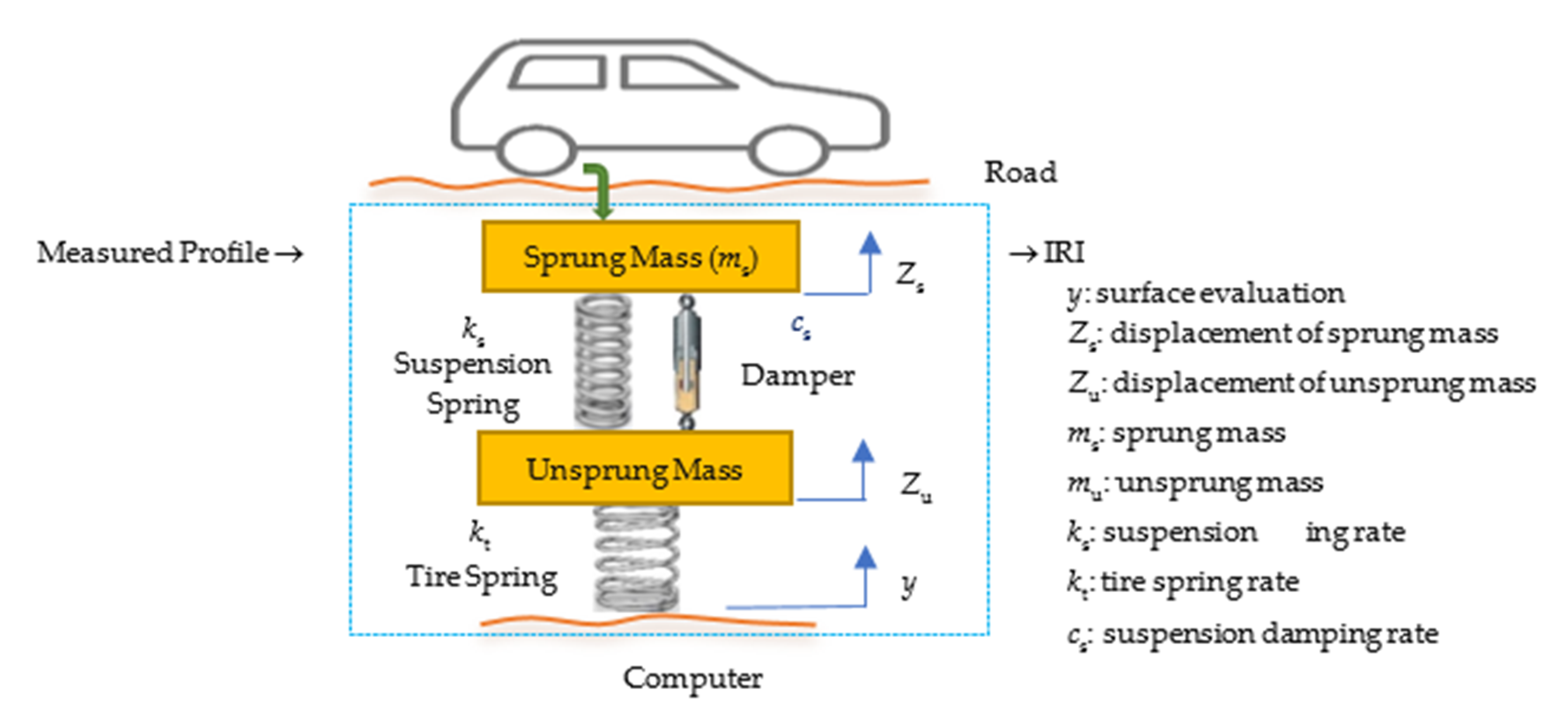
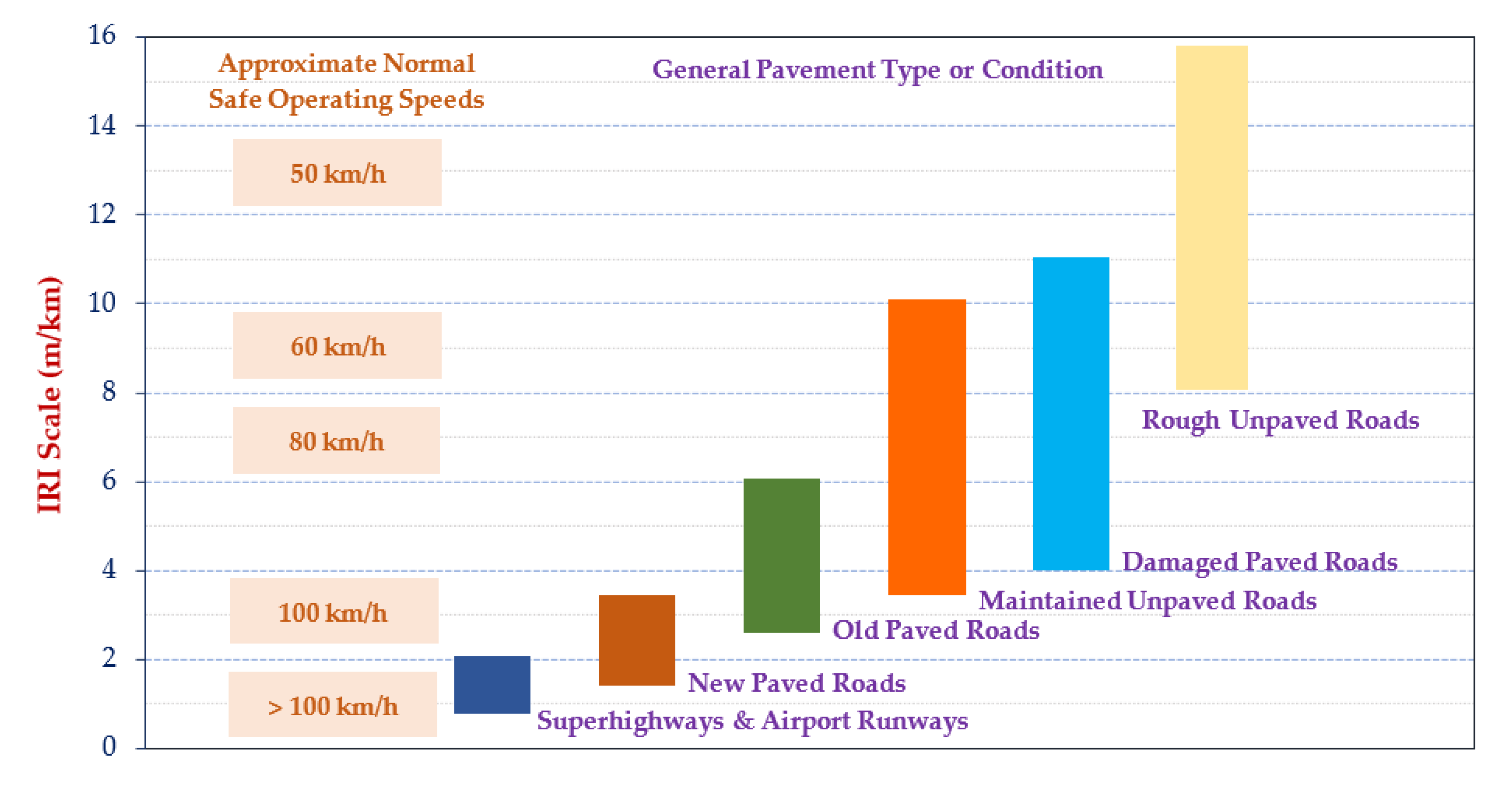
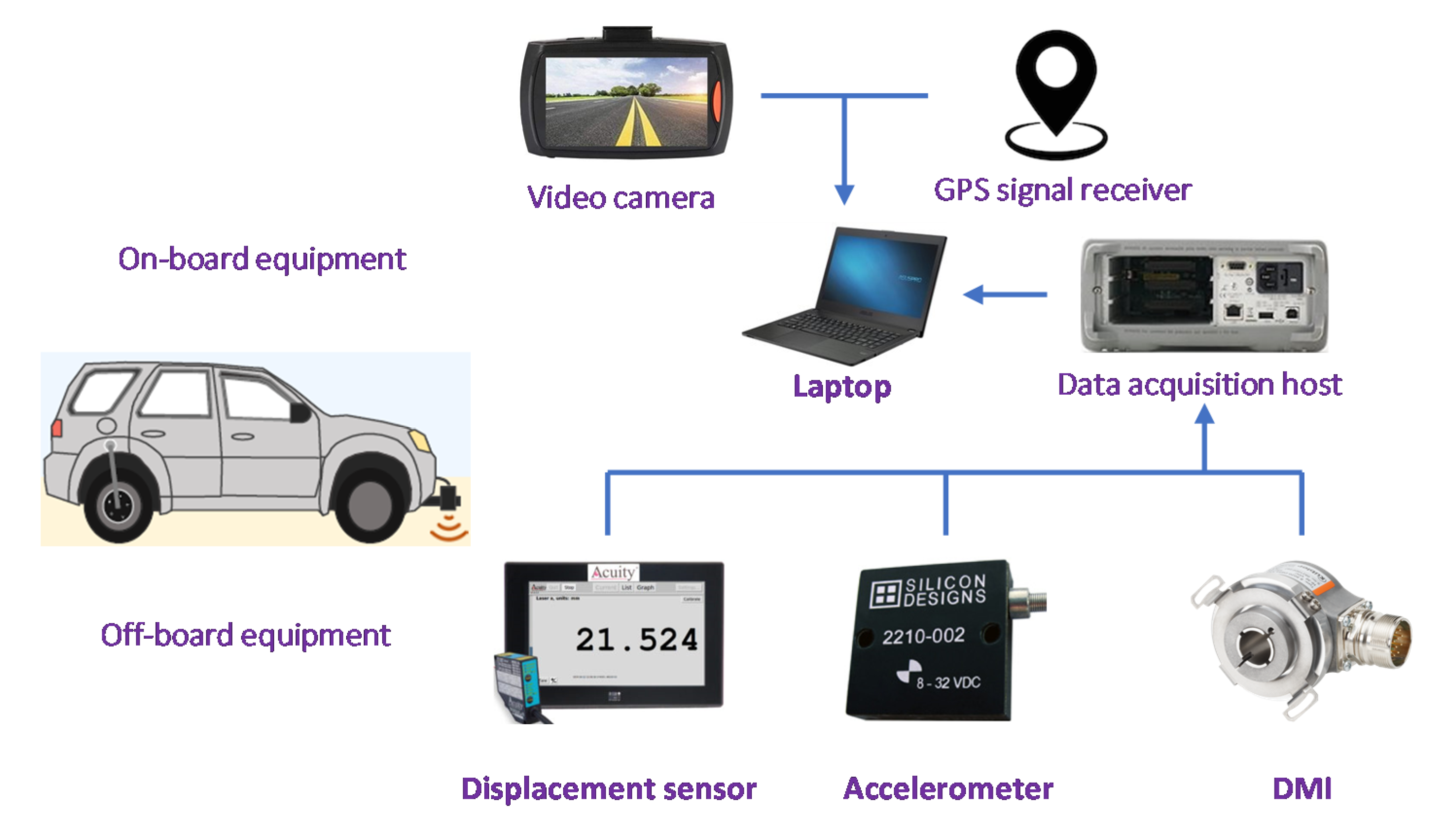
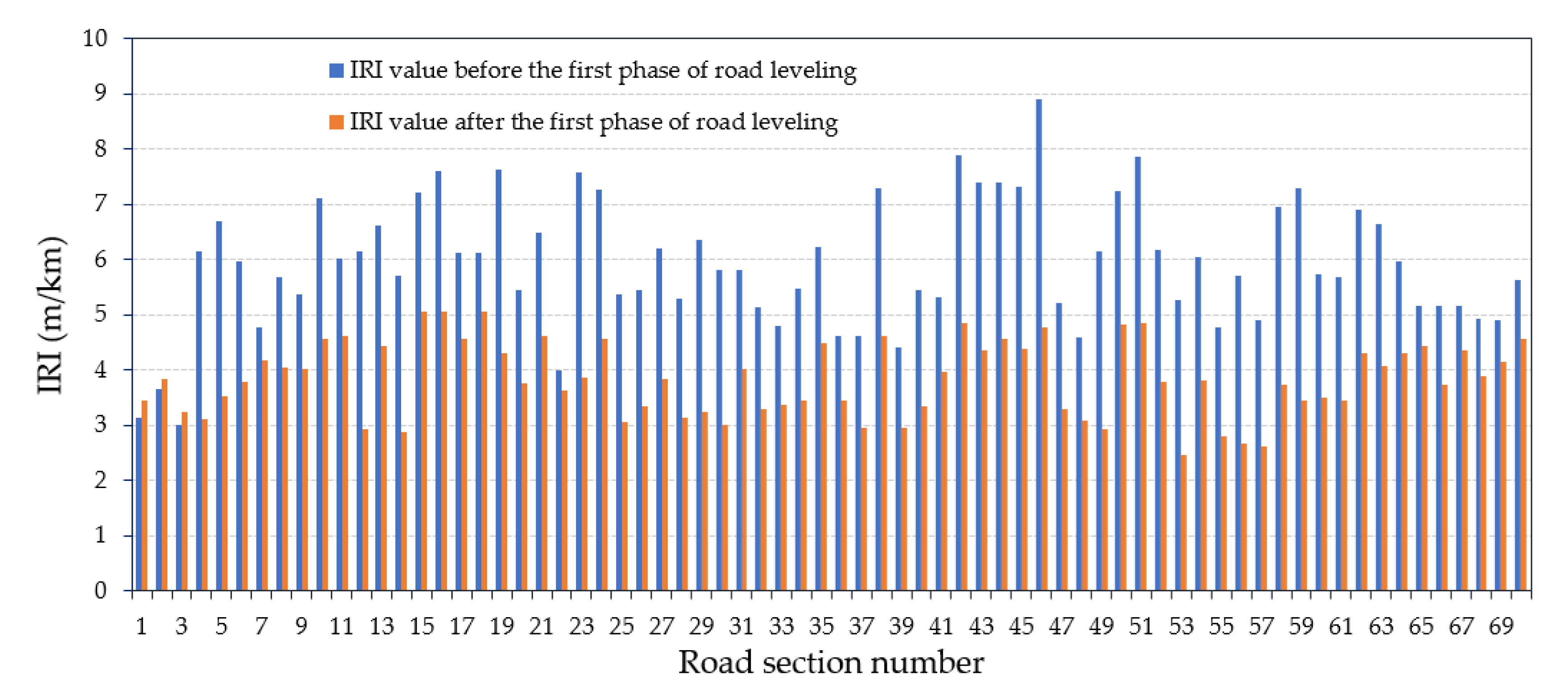
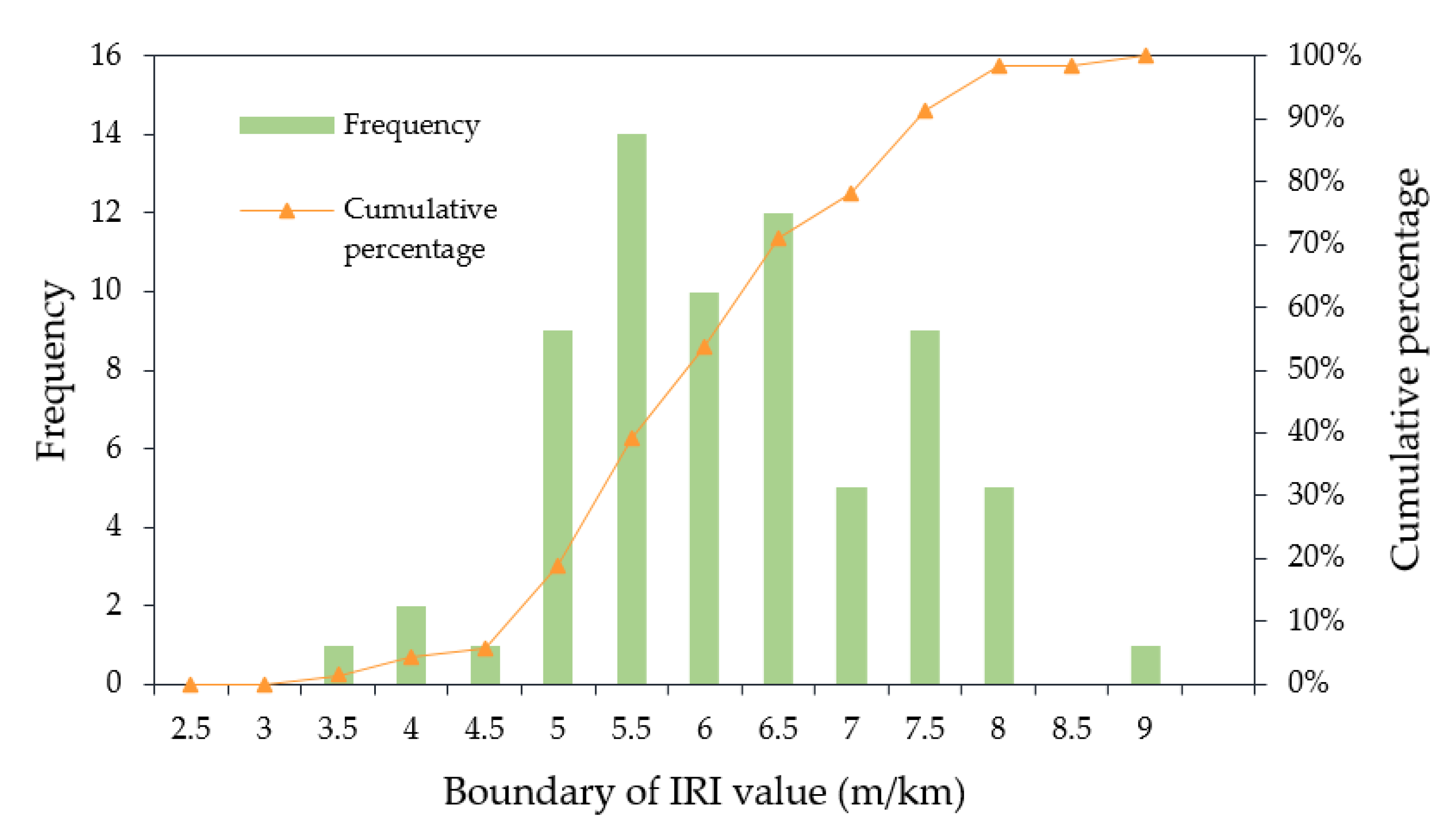
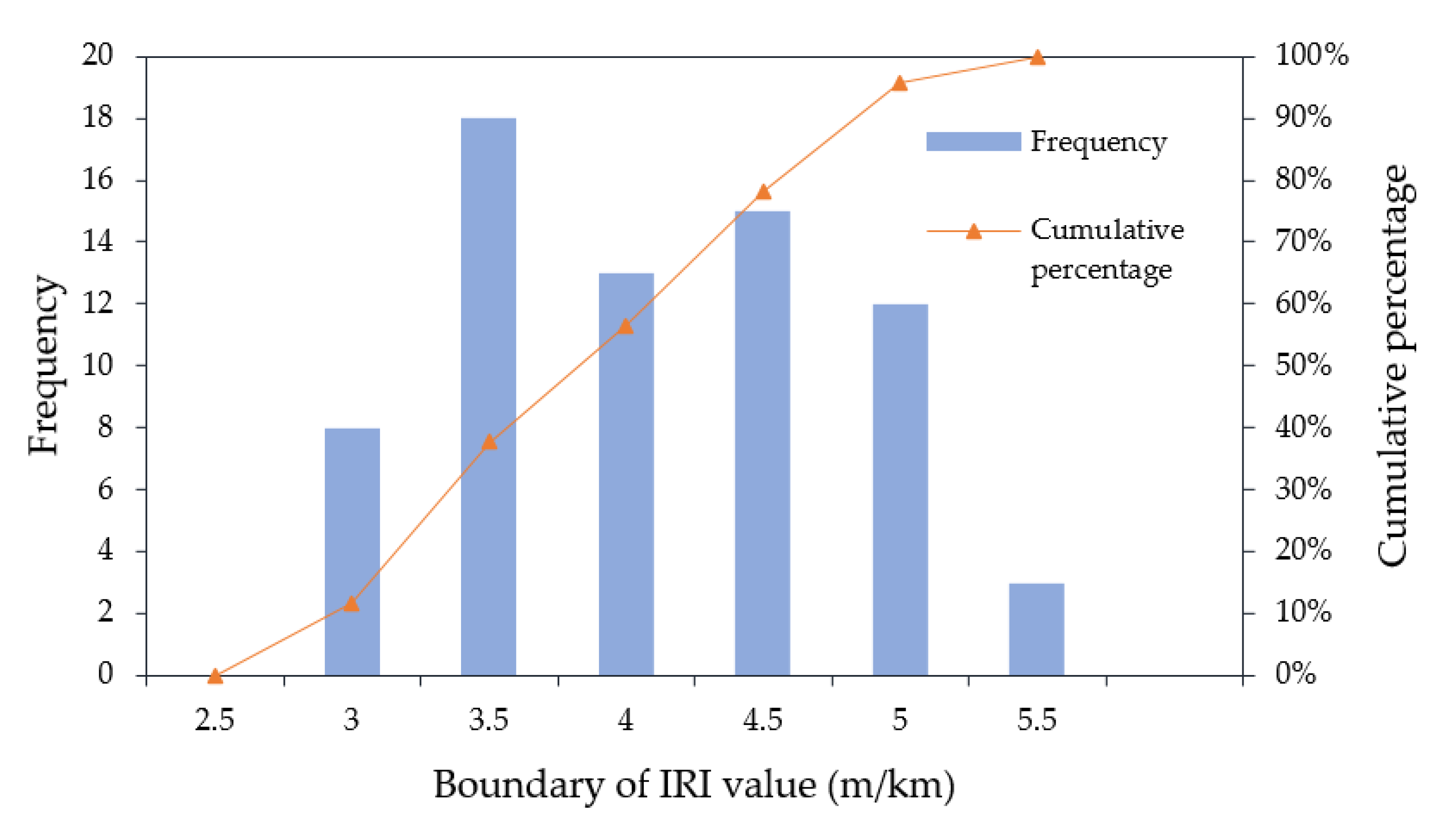
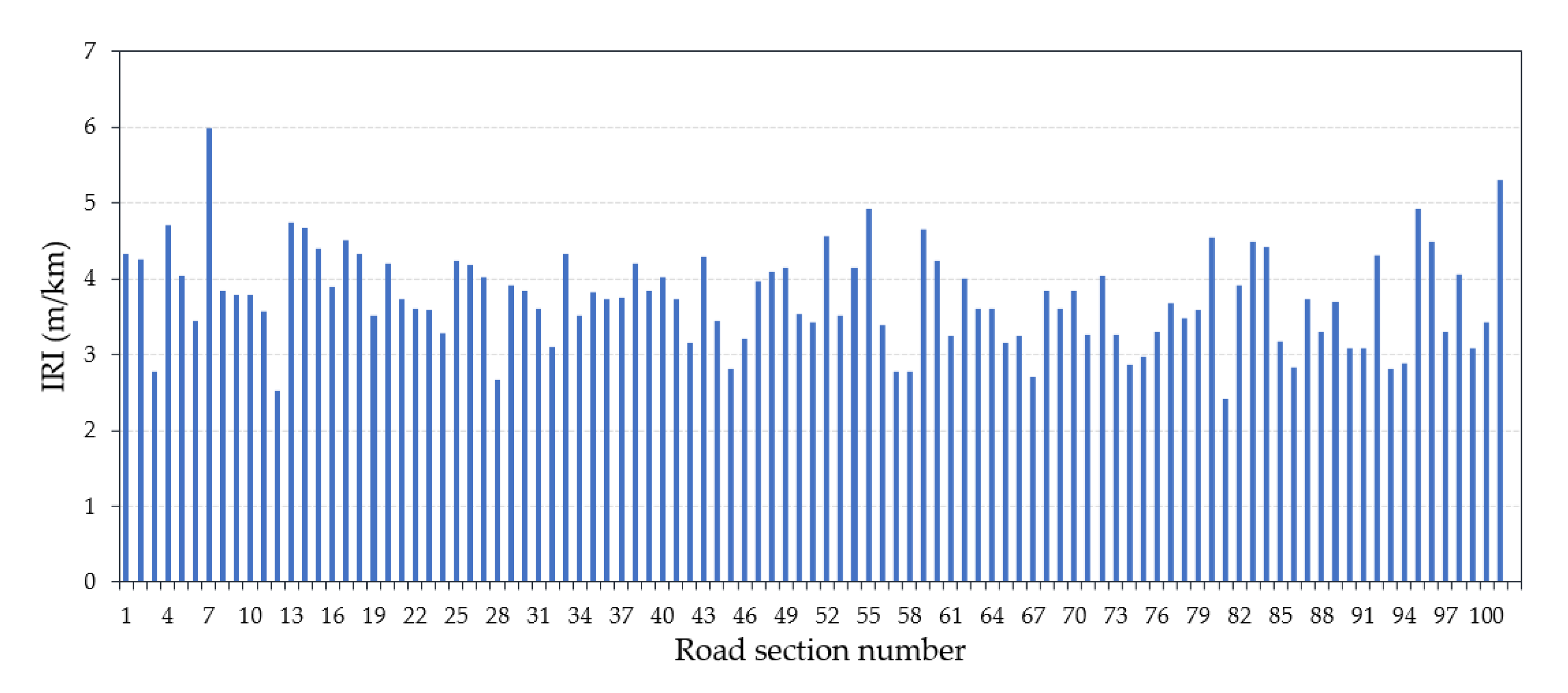
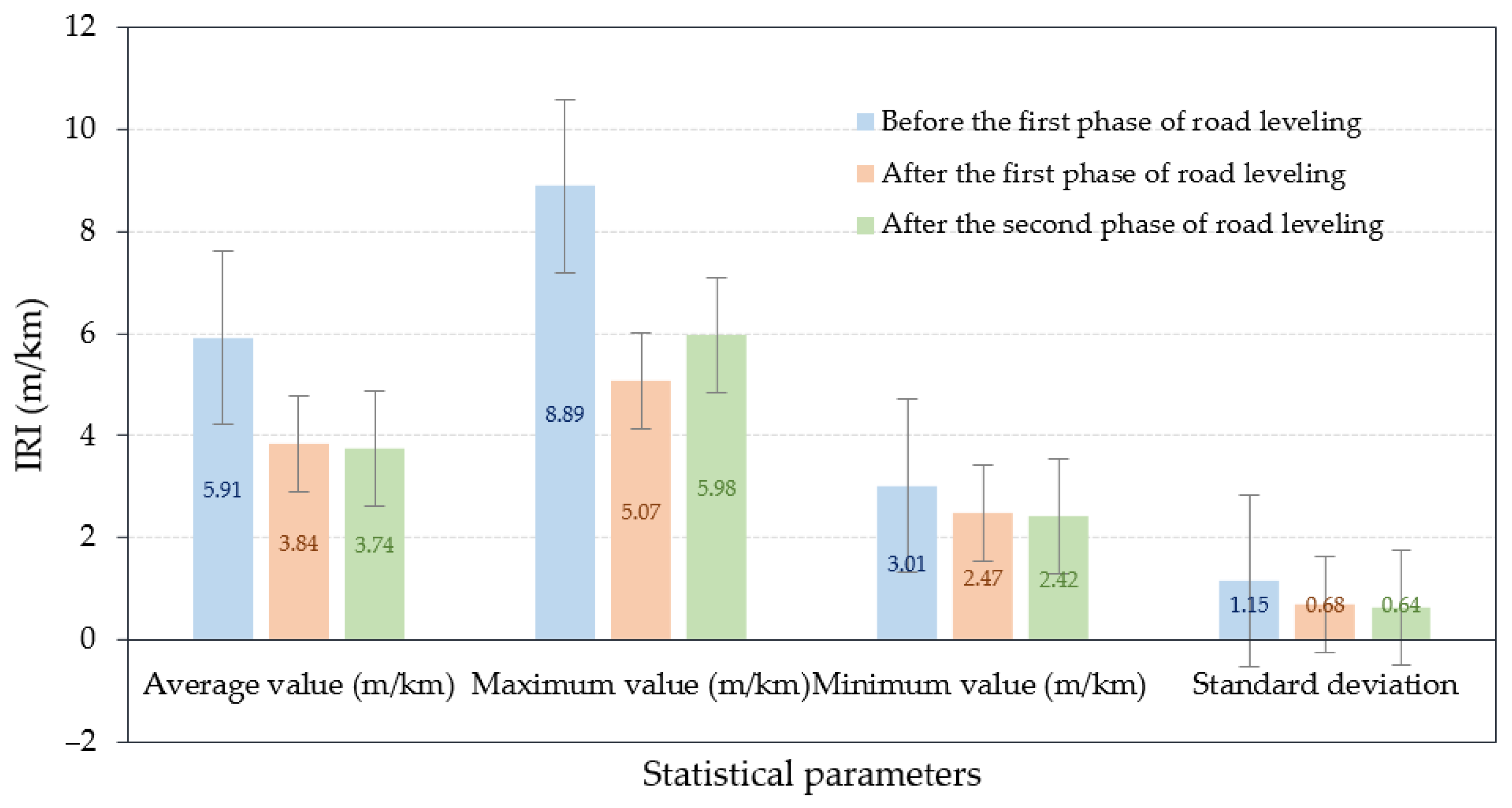
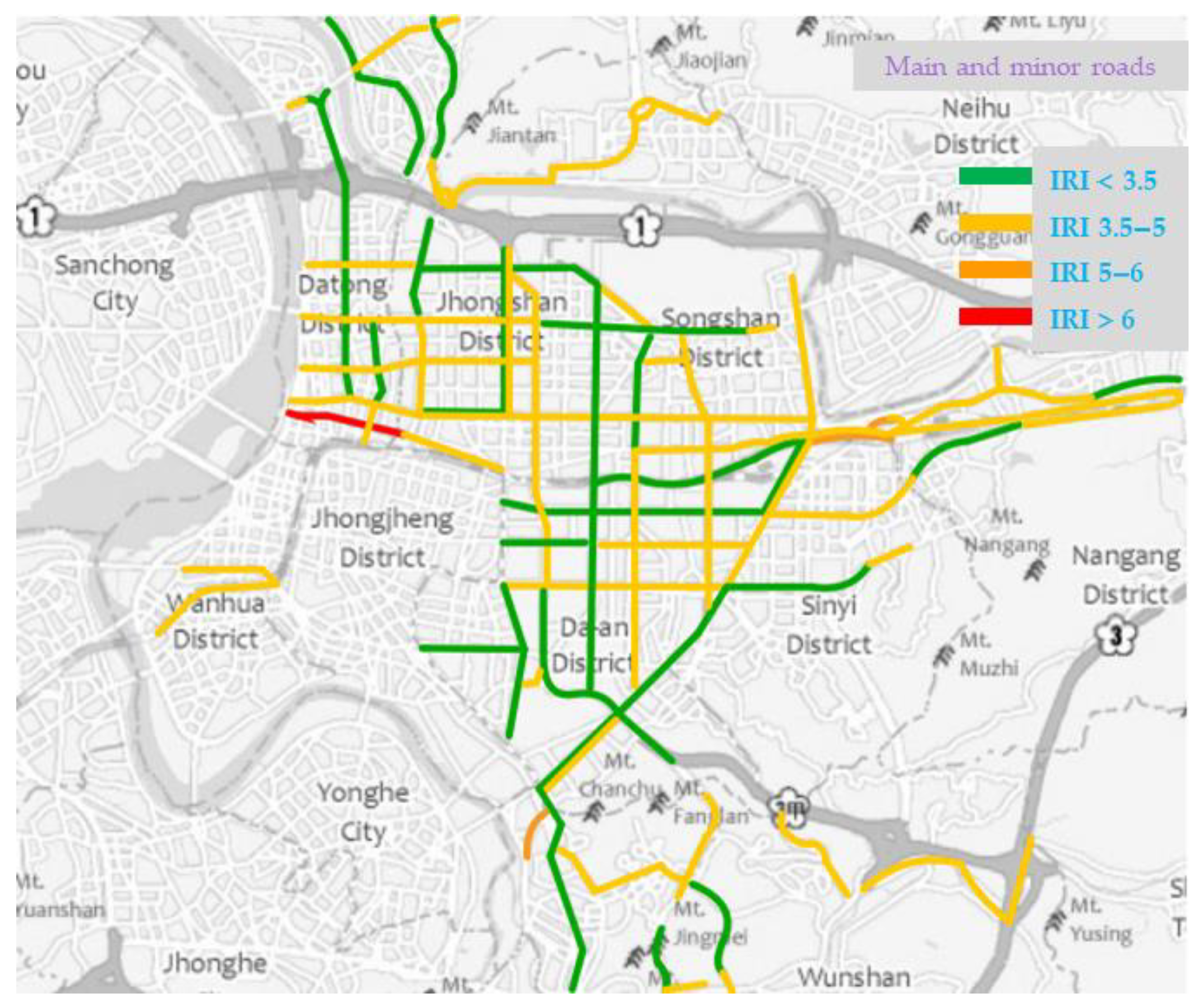
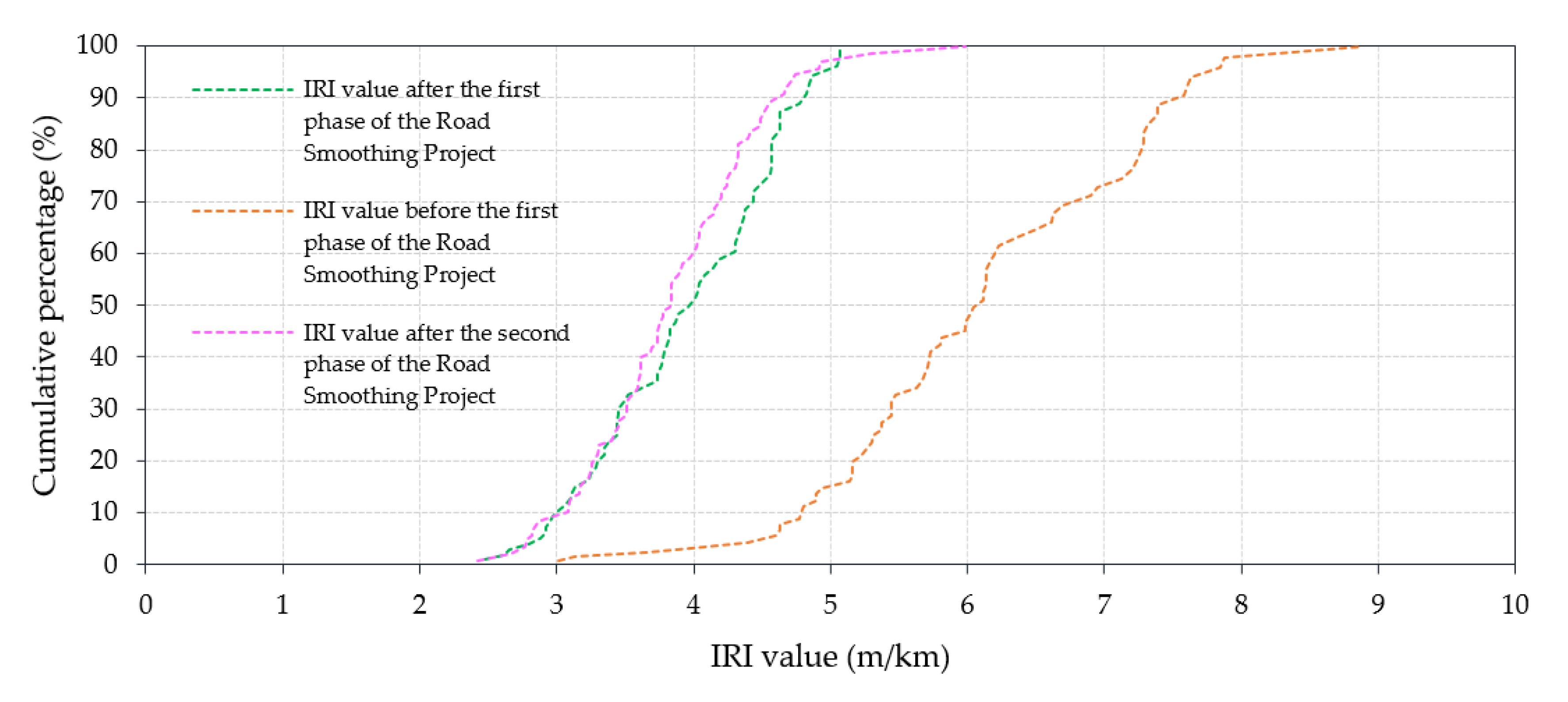
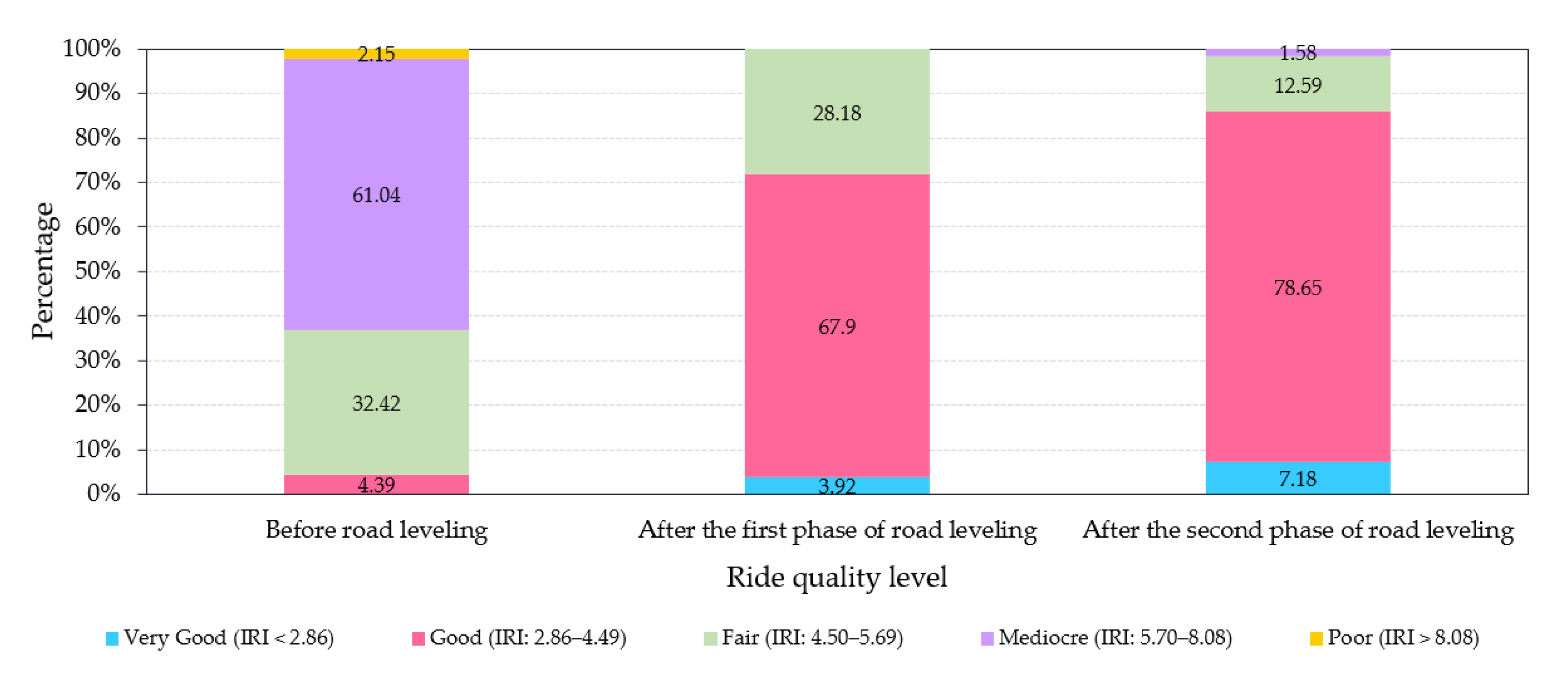
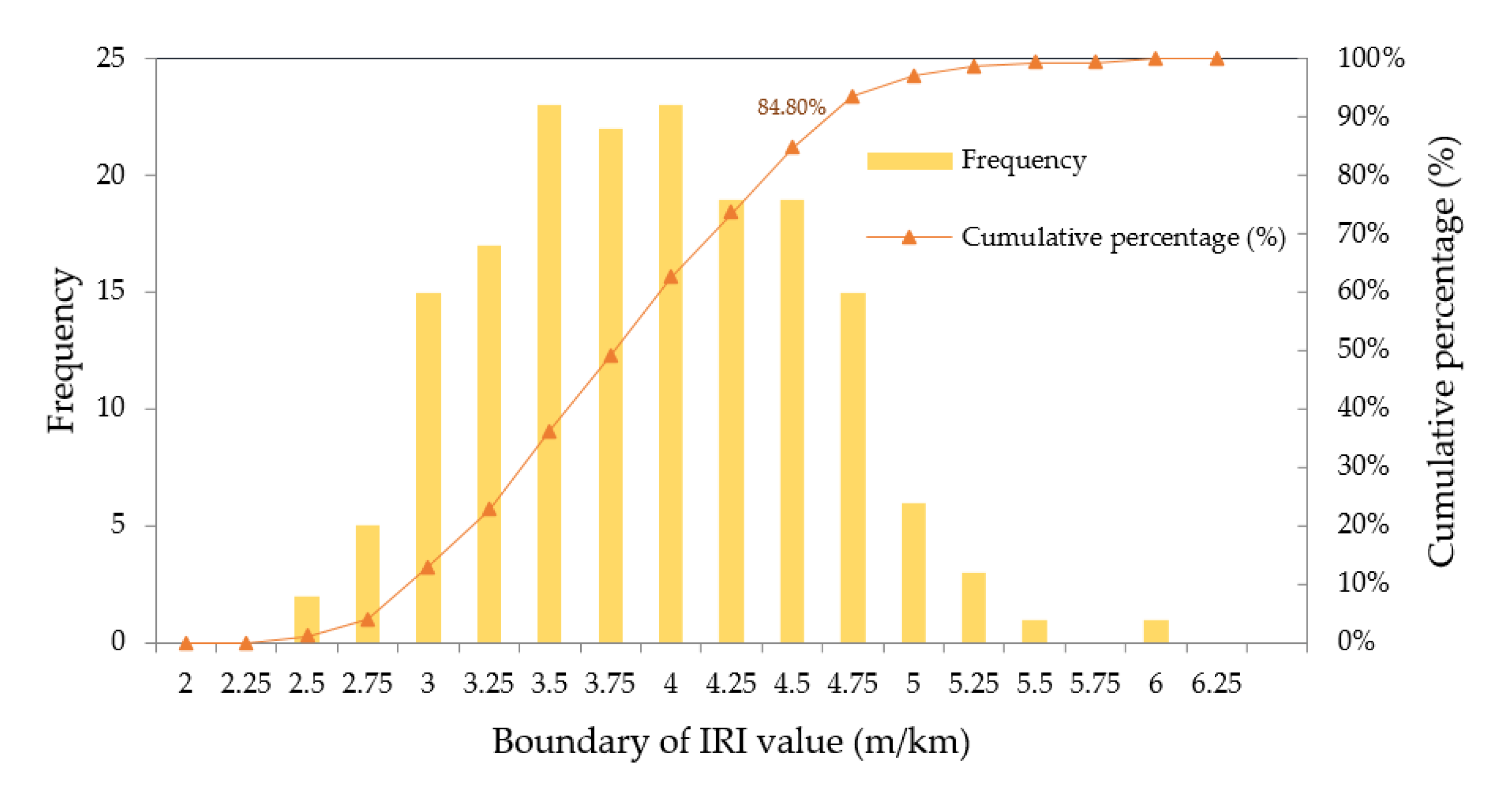
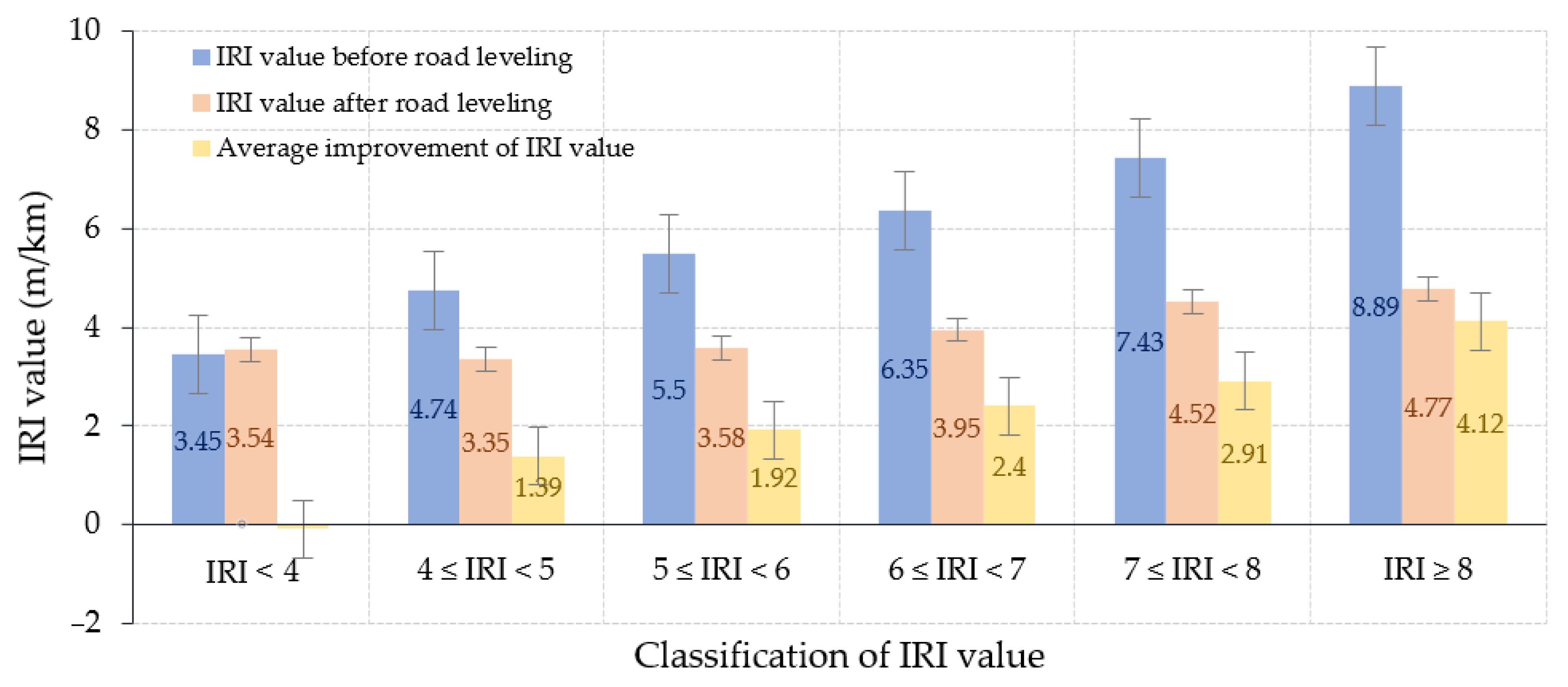
| Ride Quality Level | IRI Thresholds at Different Speeds (m/km) | |||||
|---|---|---|---|---|---|---|
| 20 | 40 | 60 | 80 | 100 | 120 | |
| Very Good | <5.72 | <2.86 | <1.90 | <1.43 | <1.14 | <0.95 |
| Good | 5.72–8.99 | 2.86–4.49 | 1.90–2.99 | 1.43–2.24 | 1.14–1.79 | 0.95–1.49 |
| Fair | 9.00–11.39 | 4.50–5.69 | 3.00–3.79 | 2.25–2.84 | 1.80–2.27 | 1.50–1.89 |
| Mediocre | 11.40–16.16 | 5.70–8.08 | 3.80–5.40 | 2.85–4.05 | 2.28–3.24 | 1.90–2.70 |
| Poor | >16.16 | >8.08 | >5.40 | >4.05 | >3.24 | >2.70 |
| Item | Stake (m) | Forward Lane | Reverse Lane | ||
|---|---|---|---|---|---|
| Car Speed (km/h) | IRI (m/km) | Car Speed (km/h) | IRI (m/km) | ||
| 1 | 50 | 22.5 | 9.07 | 20.9 | 9.51 |
| 2 | 100 | 28.8 | 7.36 | 18.8 | 8.49 |
| 3 | 150 | 30.0 | 5.74 | 15.9 | 9.14 |
| 4 | 200 | 31.8 | 6.09 | 23.9 | 9.40 |
| 5 | 250 | 28.4 | 6.88 | 23.9 | 7.58 |
| 6 | 300 | 21.2 | 5.57 | 22.1 | 7.39 |
| 7 | 350 | 21.2 | 6.01 | 20.5 | 8.75 |
| 8 | 400 | 28.0 | 4.13 | 20.3 | 9.10 |
| 9 | 450 | 30.6 | 6.59 | 18.0 | 8.26 |
| 10 | 500 | 31.6 | 8.35 | 19.7 | 8.12 |
| 11 | 550 | 20.2 | 6.53 | 18.7 | 9.15 |
| 12 | 600 | 27.2 | 7.75 | 15.6 | 6.73 |
| 13 | 650 | 29.1 | 7.41 | 21.6 | 6.34 |
| 14 | 700 | 29.0 | 5.69 | 20.6 | 6.72 |
| 15 | 750 | 27.9 | 7.70 | 22.2 | 7.44 |
| 16 | 800 | 22.2 | 7.54 | 28.1 | 7.73 |
| 17 | 850 | 16.7 | 7.84 | 19.2 | 8.24 |
| 18 | 900 | 15.1 | 6.78 | 20.3 | 7.77 |
| 19 | 950 | 24.0 | 5.65 | 21.3 | 7.50 |
| 20 | 1000 | 25.9 | 6.20 | 22.9 | 7.74 |
| 21 | 1050 | 27.1 | 11.40 | 32.1 | 8.63 |
| 22 | 1100 | 24.5 | 5.43 | 31.8 | 8.37 |
| 23 | 1150 | 25.8 | 5.22 | 30.7 | 7.10 |
| 24 | 1200 | 28.0 | 3.82 | 29.3 | 7.55 |
| 25 | 1250 | 31.3 | 3.48 | 31.8 | 4.65 |
| 26 | 1300 | 24.4 | 3.06 | 32.3 | 4.59 |
| 27 | 1350 | 13.7 | 5.80 | 32.2 | 7.67 |
| 28 | 1400 | 25.1 | 6.20 | 33.4 | 5.12 |
| 29 | 1450 | 23.9 | 7.99 | 33.3 | 4.37 |
| 30 | 1500 | 35.5 | 8.85 | 31.2 | 10.53 |
| 31 | 1550 | 37.4 | 5.95 | 24.9 | 9.76 |
| Average value | 26.1 | 6.52 | 24.4 | 7.72 | |
| Standard deviation | - | 1.73 | - | 1.52 | |
| Maximum value | 37.4 | 11.40 | 33.4 | 10.53 | |
| Minimum value | 13.7 | 3.06 | 15.6 | 4.37 | |
| Statistical Parameters | Before the First Phase of Road Leveling | After the First Phase of Road Leveling | After the Second Phase of Road Leveling |
|---|---|---|---|
| Average value (m/km) | 5.91 | 3.84 | 3.74 |
| Maximum value (m/km) | 8.89 | 5.07 | 5.98 |
| Minimum value (m/km) | 3.01 | 2.47 | 2.42 |
| Range (m/km) | 5.88 | 2.60 | 3.56 |
| Variance | 1.33 | 0.46 | 0.40 |
| Standard deviation (m/km) | 1.15 | 0.68 | 0.64 |
| Road Grade | Original IRI Value (m/km) | Evaluation Result (m/km) | ||
|---|---|---|---|---|
| Qualified Area | Correction Area | Redo Area | ||
| Expressway | IRI > 7.5 | IRI 4.5 | 4.5 < IRI 5.0 | IRI > 5.0 |
| 6.5 < IRI 7.5 | IRI 4.0 | 4.0 < IRI 4.5 | IRI > 4.5 | |
| Main and minor road (Road width > 20 m) | IRI > 7.5 | IRI 5.0 | 5.0 < IRI 5.5 | IRI > 5.5 |
| 6.5 < IRI 7.5 | IRI 4.5 | 4.5 < IRI 5.0 | IRI > 5.0 | |
| General minor road (11 m < Road width < 20 m) | IRI > 7.5 | IRI 5.0 | 5.0 < IRI 5.5 | IRI > 5.5 |
| 6.5 < IRI 7.5 | IRI 4.5 | 4.5 < IRI 5.0 | IRI > 5.0 | |
| Laneway (8 m < Road width < 11 m) | IRI > 7.5 | IRI 5.5 | 5.5 < IRI 6.0 | IRI > 6.0 |
| 6.5 < IRI 7.5 | IRI 5.0 | 5.0 < IRI 5.5 | IRI > 5.5 | |
| Road Grade | Original IRI Value (m/km) | Evaluation Result (m/km) | ||
|---|---|---|---|---|
| Qualified Area | Correction Area | Redo Area | ||
| Expressway | IRI 6.5 | IRI 3.2 | 3.2 < IRI 3.5 | IRI > 3.5 |
| Main and minor road (Road width >20 m) | IRI 7.0 | IRI 3.5 | 3.5 < IRI 3.8 | IRI > 3.8 |
| General minor road (11 m < Road width < 20 m) | IRI 7.0 | IRI 3.5 | 3.5 < IRI 3.8 | IRI > 3.8 |
| Laneway (8 m < Road width < 11 m) | IRI 7.5 | IRI 4.0 | 4.0 < IRI 4.3 | IRI > 4.3 |
| Road Section Number | IRI Value Before Leveling | IRI Value After Leveling | Length of Road Section (m) | Evaluation Result |
|---|---|---|---|---|
| 1 | 3.13 | 3.45 | 4000 | Qualified area |
| 2 | 3.66 | 3.83 | 4100 | Redo area |
| 3 | 3.01 | 3.25 | 2900 | Qualified area |
| 4 | 6.14 | 3.11 | 2500 | Qualified area |
| 6 | 5.98 | 3.79 | 4600 | Correction area |
| 7 | 4.78 | 4.18 | 2400 | Redo area |
| 8 | 5.69 | 4.04 | 3600 | Redo area |
| 9 | 5.37 | 4.03 | 5000 | Redo area |
| 10 | 7.12 | 4.57 | 3100 | Redo area |
| 11 | 6.01 | 4.63 | 2700 | Redo area |
| 12 | 6.14 | 2.92 | 1400 | Qualified area |
| 14 | 5.71 | 2.88 | 5300 | Qualified area |
| 15 | 7.21 | 5.05 | 2700 | Redo area |
| 16 | 7.6 | 5.07 | 5600 | Redo area |
| 17 | 6.12 | 4.57 | 3750 | Redo area |
| 18 | 6.12 | 5.07 | 3750 | Redo area |
| 20 | 5.44 | 3.77 | 2100 | Correction area |
| 21 | 6.48 | 4.63 | 2600 | Redo area |
| 22 | 3.99 | 3.62 | 3500 | Correction area |
| 25 | 5.37 | 3.06 | 3200 | Qualified area |
| 26 | 5.44 | 3.35 | 2800 | Qualified area |
| 27 | 6.2 | 3.83 | 4300 | Redo area |
| 28 | 5.3 | 3.13 | 1300 | Qualified area |
| 29 | 6.36 | 3.24 | 2200 | Qualified area |
| 30 | 5.8 | 3.01 | 1500 | Qualified area |
| 31 | 5.81 | 4.01 | 1400 | Redo area |
| 32 | 5.14 | 3.29 | 3500 | Qualified area |
| 33 | 4.8 | 3.38 | 4000 | Qualified area |
| 34 | 5.47 | 3.45 | 4300 | Qualified area |
| 35 | 6.23 | 4.5 | 1700 | Redo area |
| 36 | 4.63 | 3.44 | 2000 | Qualified area |
| 37 | 4.63 | 2.97 | 2300 | Qualified area |
| 39 | 4.4 | 2.95 | 2400 | Qualified area |
| 40 | 5.44 | 3.35 | 2800 | Qualified area |
| 41 | 5.31 | 3.96 | 3200 | Redo area |
| 47 | 5.22 | 3.3 | 2100 | Qualified area |
| 48 | 4.6 | 3.1 | 2200 | Qualified area |
| 49 | 6.14 | 2.92 | 1400 | Qualified area |
| 52 | 6.17 | 3.78 | 6400 | Correction area |
| 53 | 5.26 | 2.47 | 1200 | Qualified area |
| 54 | 6.04 | 3.81 | 700 | Redo area |
| 55 | 4.77 | 2.8 | 1600 | Qualified area |
| 56 | 5.72 | 2.66 | 2400 | Qualified area |
| 57 | 4.9 | 2.62 | 2700 | Qualified area |
| 60 | 5.73 | 3.49 | 1800 | Qualified area |
| 61 | 5.67 | 3.44 | 3700 | Qualified area |
| 64 | 5.98 | 4.3 | 3500 | Redo area |
| 65 | 5.16 | 4.44 | 2400 | Redo area |
| 66 | 5.16 | 3.73 | 2400 | Correction area |
| 67 | 5.16 | 4.37 | 2200 | Redo area |
| 68 | 4.94 | 3.89 | 3600 | Redo area |
| 69 | 4.9 | 4.14 | 1500 | Redo area |
| 70 | 5.63 | 4.57 | 2300 | Redo area |
| Road Section Number | IRI Value Before Leveling | IRI Value After Leveling | Length of Road Section (m) | Evaluation Result |
|---|---|---|---|---|
| 5 | 6.7 | 3.52 | 2600 | Qualified area |
| 13 | 6.61 | 4.44 | 2300 | Qualified area |
| 19 | 7.63 | 4.3 | 1000 | Qualified area |
| 23 | 7.58 | 3.87 | 900 | Qualified area |
| 24 | 7.27 | 4.56 | 1400 | Correction area |
| 38 | 7.29 | 4.63 | 1350 | Correction area |
| 42 | 7.88 | 4.86 | 2100 | Qualified area |
| 43 | 7.39 | 4.35 | 1400 | Qualified area |
| 44 | 7.39 | 4.57 | 1400 | Correction area |
| 45 | 7.32 | 4.38 | 1500 | Qualified area |
| 46 | 8.89 | 4.77 | 1000 | Qualified area |
| 50 | 7.24 | 4.82 | 1500 | Correction area |
| 51 | 7.85 | 4.84 | 3200 | Qualified area |
| 58 | 6.95 | 3.73 | 1700 | Qualified area |
| 59 | 7.29 | 3.44 | 2300 | Qualified area |
| 62 | 6.9 | 4.32 | 900 | Qualified area |
| 63 | 6.63 | 4.08 | 2200 | Qualified area |
| Classification of IRI Value | IRI Value Before Road Leveling | IRI Value After Road Leveling | Average IRI After Improvement |
|---|---|---|---|
| IRI < 4 | 3.45 | 3.54 | −0.09 |
| 4 ≤ IRI < 5 | 4.74 | 3.35 | 1.39 |
| 5 ≤ IRI < 6 | 5.50 | 3.58 | 1.92 |
| 6 ≤ IRI < 7 | 6.35 | 3.95 | 2.40 |
| 7 ≤ IRI < 8 | 7.43 | 4.52 | 2.91 |
| IRI ≥ 8 | 8.89 | 4.77 | 4.12 |
Publisher’s Note: MDPI stays neutral with regard to jurisdictional claims in published maps and institutional affiliations. |
© 2020 by the authors. Licensee MDPI, Basel, Switzerland. This article is an open access article distributed under the terms and conditions of the Creative Commons Attribution (CC BY) license (http://creativecommons.org/licenses/by/4.0/).
Share and Cite
Chen, S.-L.; Lin, C.-H.; Tang, C.-W.; Chu, L.-P.; Cheng, C.-K. Research on the International Roughness Index Threshold of Road Rehabilitation in Metropolitan Areas: A Case Study in Taipei City. Sustainability 2020, 12, 10536. https://doi.org/10.3390/su122410536
Chen S-L, Lin C-H, Tang C-W, Chu L-P, Cheng C-K. Research on the International Roughness Index Threshold of Road Rehabilitation in Metropolitan Areas: A Case Study in Taipei City. Sustainability. 2020; 12(24):10536. https://doi.org/10.3390/su122410536
Chicago/Turabian StyleChen, Shong-Loong, Chih-Hsien Lin, Chao-Wei Tang, Liang-Pin Chu, and Chiu-Kuei Cheng. 2020. "Research on the International Roughness Index Threshold of Road Rehabilitation in Metropolitan Areas: A Case Study in Taipei City" Sustainability 12, no. 24: 10536. https://doi.org/10.3390/su122410536
APA StyleChen, S.-L., Lin, C.-H., Tang, C.-W., Chu, L.-P., & Cheng, C.-K. (2020). Research on the International Roughness Index Threshold of Road Rehabilitation in Metropolitan Areas: A Case Study in Taipei City. Sustainability, 12(24), 10536. https://doi.org/10.3390/su122410536






